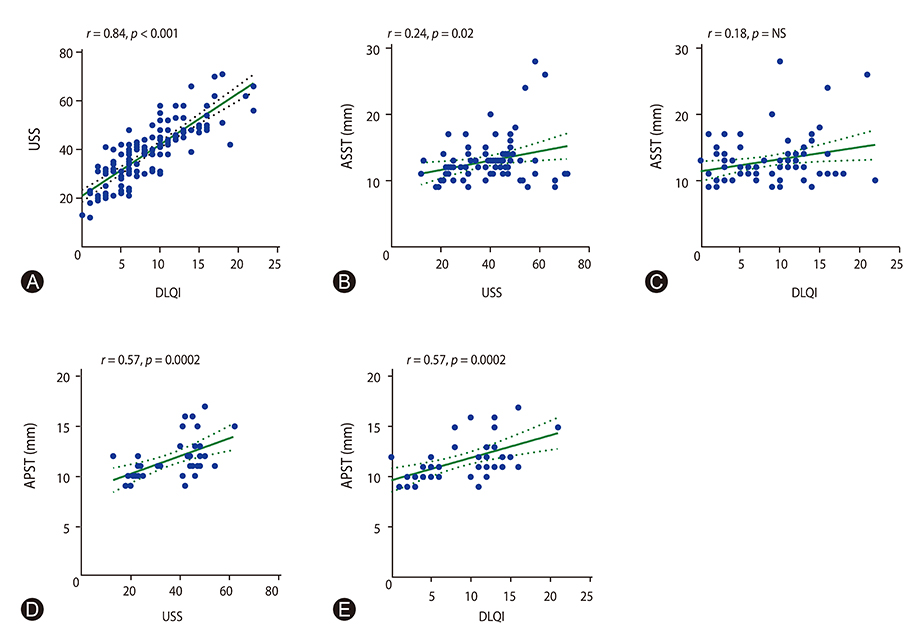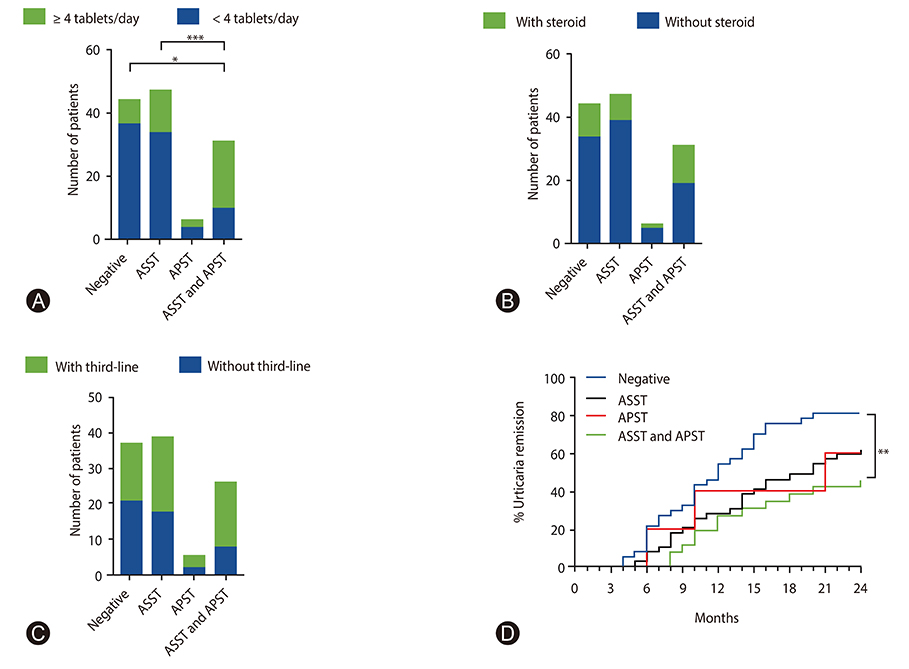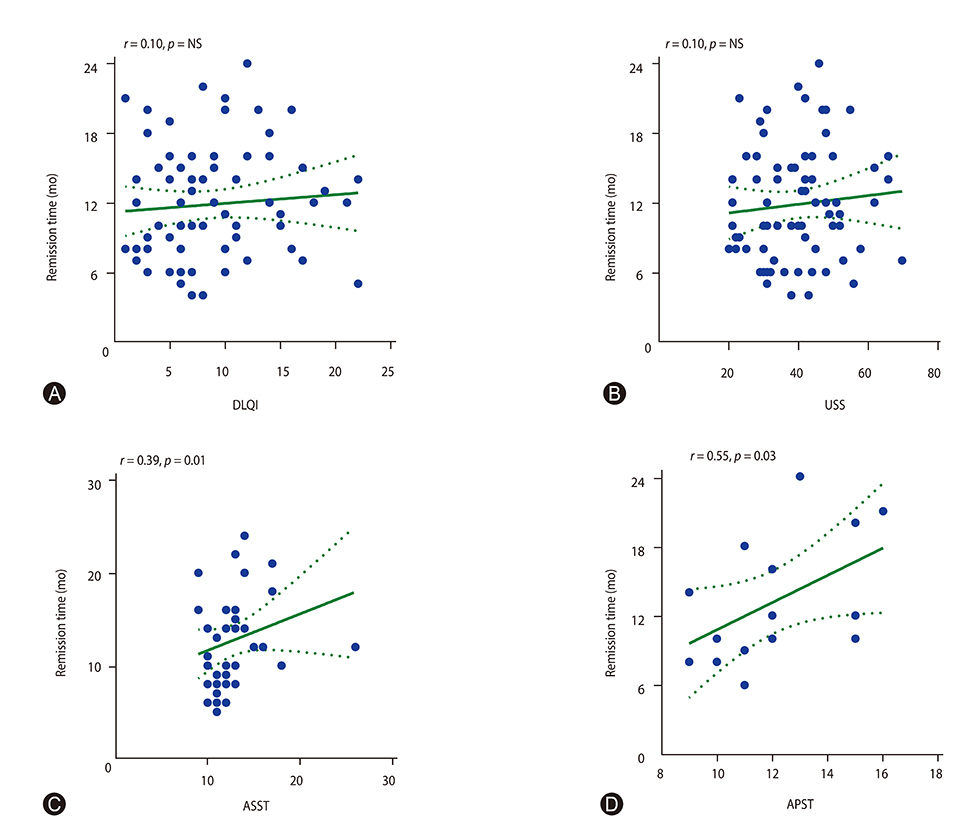Asia Pac Allergy.
2016 Oct;6(4):226-235. 10.5415/apallergy.2016.6.4.226.
Autologous serum and plasma skin test to predict 2-year outcome in chronic spontaneous urticaria
- Affiliations
-
- 1Division of Allergy and Clinical Immunology, Department of Medicine, Phramongkutklao Hospital, Bangkok 10400, Thailand. tadechb@pmk.ac.th
- KMID: 2397019
- DOI: http://doi.org/10.5415/apallergy.2016.6.4.226
Abstract
- BACKGROUND
Autologous serum skin test (ASST) and autologous plasma skin test (APST) are simple methods to diagnose autoimmune chronic urticaria. However, the association data of ASST or APST with disease severity and long-term outcome are still unclear.
OBJECTIVE
The results of ASST and APST might be used to predict urticaria symptom severity and long-term outcomes among chronic spontaneous urticaria (CSU) patients.
METHODS
We evaluated the prevalence of reactive ASST and APST in 128 CSU patients. The patients were characterized by 4 groups: negative, ASST positive, APST positive, and both ASST and APST positive. We observed remission rate among the CSU patients during 2 years.
RESULTS
Forty-four of 128 CSU patients (34%) had negative autologous skin test. The CSU patients with positive ASST, positive APST, and both positive ASST and APST were 47 (37%), 6 (5%), and 31 (24%), respectively. No significant difference was found between the groups according to urticaria severity score (USS) and dermatology life quality index (DLQI). Mean wheal diameter of ASST showed positive correlation with DLQI. Also, mean wheal diameter of APST showed positive correlation with USS and DLQI. Both the positive ASST and APST groups had a high proportion of 4-fold dose of H1-antihistamine than the positive ASST (p = 0.03) and negative groups (p = 0.0009). The rate of remission over 2 years in the negative, positive ASST, positive APST, and both positive ASST and APST groups were 81.1%, 62.3%, 60%, and 46.1%, respectively. The urticaria remission rate in patients in the negative group was significantly higher compared with both positive ASST and APST groups (odds ratio, 5.0; 95% confidence interval, 1.61-15.44; p = 0.006).
CONCLUSION
ASST and APST results could predict remission rates among patients with CSU. Our results suggested investigating ASST and APST among CSU patients before starting treatment.
Keyword
Figure
Cited by 2 articles
-
Cold Urticaria: Clinical Features and Natural Course in a Tropical Country
Kanokvalai Kulthanan, Papapit Tuchinda, Leena Chularojanamontri, Rungsima Kiratiwongwan
Allergy Asthma Immunol Res. 2019;11(4):538-547. doi: 10.4168/aair.2019.11.4.538.Greetings from Asia Pacific Allergy
Yoon-Seok Chang
Asia Pac Allergy. 2016;6(4):195-197. doi: 10.5415/apallergy.2016.6.4.195.
Reference
-
1. Ozkan M, Oflaz SB, Kocaman N, Ozseker F, Gelincik A, Büyüköztürk S, Ozkan S, Colakoğlu B. Psychiatric morbidity and quality of life in patients with chronic idiopathic urticaria. Ann Allergy Asthma Immunol. 2007; 99:29–33.2. Engin B, Uguz F, Yilmaz E, Ozdemir M, Mevlitoglu I. The levels of depression, anxiety and quality of life in patients with chronic idiopathic urticaria. J Eur Acad Dermatol Venereol. 2008; 22:36–40.
Article3. Maurer M, Weller K, Bindslev-Jensen C, Giménez-Arnau A, Bousquet PJ, Bousquet J, Canonica GW, Church MK, Godse KV, Grattan CE, Greaves MW, Hide M, Kalogeromitros D, Kaplan AP, Saini SS, Zhu XJ, Zuberbier T. Unmet clinical needs in chronic spontaneous urticaria. A GA2LEN task force report. Allergy. 2011; 66:317–330.4. Toubi E, Kessel A, Avshovich N, Bamberger E, Sabo E, Nusem D, Panasoff J. Clinical and laboratory parameters in predicting chronic urticaria duration: a prospective study of 139 patients. Allergy. 2004; 59:869–873.
Article5. Khan DA. Chronic urticaria: diagnosis and management. Allergy Asthma Proc. 2008; 29:439–446.
Article6. Kaplan AP. Chronic urticaria: pathogenesis and treatment. J Allergy Clin Immunol. 2004; 114:465–474.
Article7. Hide M, Francis DM, Grattan CE, Hakimi J, Kochan JP, Greaves MW. Autoantibodies against the high-affinity IgE receptor as a cause of histamine release in chronic urticaria. N Engl J Med. 1993; 328:1599–1604.
Article8. Sabroe RA, Fiebiger E, Francis DM, Maurer D, Seed PT, Grattan CE, Black AK, Stingl G, Greaves MW, Barr RM. Classification of anti-FcepsilonRI and anti-IgE autoantibodies in chronic idiopathic urticaria and correlation with disease severity. J Allergy Clin Immunol. 2002; 110:492–499.9. Tedeschi A, Kolkhir P, Asero R, Pogorelov D, Olisova O, Kochergin N, Cugno M. Chronic urticaria and coagulation: pathophysiological and clinical aspects. Allergy. 2014; 69:683–691.
Article10. Konstantinou GN, Asero R, Ferrer M, Knol EF, Maurer M, Raap U, Schmid-Grendelmeier P, Skov PS, Grattan CE. EAACI taskforce position paper: evidence for autoimmune urticaria and proposal for defining diagnostic criteria. Allergy. 2013; 68:27–36.
Article11. Asero R, Tedeschi A, Riboldi P, Cugno M. Plasma of patients with chronic urticaria shows signs of thrombin generation, and its intradermal injection causes wheal-and-flare reactions much more frequently than autologous serum. J Allergy Clin Immunol. 2006; 117:1113–1117.
Article12. Sabroe RA, Seed PT, Francis DM, Barr RM, Black AK, Greaves MW. Chronic idiopathic urticaria: comparison of the clinical features of patients with and without anti-FcepsilonRI or anti-IgE autoantibodies. J Am Acad Dermatol. 1999; 40:443–450.13. Caproni M, Volpi W, Giomi B, Cardinali C, Antiga E, Melani L, Dagata A, Fabbri P. Chronic idiopathic and chronic autoimmune urticaria: clinical and immunopathological features of 68 subjects. Acta Derm Venereol. 2004; 84:288–290.
Article14. Kim JH, Lee HY, Ban GY, Shin YS, Park HS, Ye YM. Serum clusterin as a prognostic marker of chronic spontaneous urticaria. Medicine (Baltimore). 2016; 95:e3688.
Article15. Woo YR, Jung KE, Koo DW, Lee JS. Vitamin D as a Marker for disease severity in chronic urticaria and its possible role in pathogenesis. Ann Dermatol. 2015; 27:423–430.
Article16. Boonpiyathad T, Pradubpongsa P, Sangasapaviriya A. Vitamin d supplements improve urticaria symptoms and quality of life in chronic spontaneous urticaria patients: a prospective case-control study. Dermatoendocrinol. 2014; 6:e29727.
Article17. Atwa MA, Emara AS, Youssef N, Bayoumy NM. Serum concentration of IL-17, IL-23 and TNF-α among patients with chronic spontaneous urticaria: association with disease activity and autologous serum skin test. J Eur Acad Dermatol Venereol. 2014; 28:469–474.
Article18. Jariwala SP, Moday H, de Asis ML, Fodeman J, Hudes G, de Vos G, Rosenstreich D. The Urticaria Severity Score: a sensitive questionnaire/index for monitoring response to therapy in patients with chronic urticaria. Ann Allergy Asthma Immunol. 2009; 102:475–482.
Article19. Finlay AY, Khan GK. Dermatology Life Quality Index (DLQI): a simple practical measure for routine clinical use. Clin Exp Dermatol. 1994; 19:210–216.20. Zuberbier T, Asero R, Bindslev-Jensen C, Walter Canonica G, Church MK, Giménez-Arnau AM, Grattan CE, Kapp A, Maurer M, Merk HF, Rogala B, Saini S, Sánchez-Borges M, Schmid-Grendelmeier P, Schünemann H, Staubach P, Vena GA, Wedi B. Dermatology Section of the European Academy of Allergology and Clinical Immunology. Global Allergy and Asthma European Network. European Dermatology Forum. World Allergy Organization. EAACI/GA(2)LEN/EDF/WAO guideline: management of urticaria. Allergy. 2009; 64:1427–1443.21. Zuberbier T, Aberer W, Asero R, Bindslev-Jensen C, Brzoza Z, Canonica GW, Church MK, Ensina LF, Giménez-Arnau A, Godse K, Gonçalo M, Grattan C, Hebert J, Hide M, Kaplan A, Kapp A, Abdul Latiff AH, Mathelier-Fusade P, Metz M, Nast A, Saini SS, Sánchez-Borges M, Schmid-Grendelmeier P, Simons FE, Staubach P, Sussman G, Toubi E, Vena GA, Wedi B, Zhu XJ, Maurer M. European Academy of Allergy and Clinical Immunology. Global Allergy and Asthma European Network. European Dermatology Forum; World Allergy Organization. The EAACI/GA(2) LEN/EDF/WAO Guideline for the definition, classification, diagnosis, and management of urticaria: the 2013 revision and update. Allergy. 2014; 69:868–887.22. Staevska M, Popov TA, Kralimarkova T, Lazarova C, Kraeva S, Popova D, Church DS, Dimitrov V, Church MK. The effectiveness of levocetirizine and desloratadine in up to 4 times conventional doses in difficult-to-treat urticaria. J Allergy Clin Immunol. 2010; 125:676–682.
Article23. Asero R, Tedeschi A. Usefulness of a short course of oral prednisone in antihistamine-resistant chronic urticaria: a retrospective analysis. J Investig Allergol Clin Immunol. 2010; 20:386–390.24. Zhong H, Song Z, Chen W, Li H, He L, Gao T, Fang H, Guo Z, Xv J, Yu B, Gao X, Xie H, Gu H, Luo D, Chen X, Lei T, Gu J, Cheng B, Duan Y, Xv A, Zhu X, Hao F. Chronic urticaria in Chinese population: a hospital-based multicenter epidemiological study. Allergy. 2014; 69:359–364.
Article25. Sajedi V, Movahedi M, Aghamohammadi A, Gharagozlou M, Shafiei A, Soheili H, Sanajian N. Comparison between sensitivity of autologous skin serum test and autologous plasma skin test in patients with Chronic Idiopathic Urticaria for detection of antibody against IgE or IgE receptor (FcεRIα). Iran J Allergy Asthma Immunol. 2011; 10:111–117.26. Sabroe RA, Grattan CE, Francis DM, Barr RM, Kobza Black A, Greaves MW. The autologous serum skin test: a screening test for autoantibodies in chronic idiopathic urticaria. Br J Dermatol. 1999; 140:446–452.
Article27. Guttman-Yassky E, Bergman R, Maor C, Mamorsky M, Pollack S, Shahar E. The autologous serum skin test in a cohort of chronic idiopathic urticaria patients compared to respiratory allergy patients and healthy individuals. J Eur Acad Dermatol Venereol. 2007; 21:35–39.
Article28. Kulthanan K, Jiamton S, Gorvanich T, Pinkaew S. Autologous serum skin test in chronic idiopathic urticaria: prevalence, correlation and clinical implications. Asian Pac J Allergy Immunol. 2006; 24:201–206.29. Taskapan O, Kutlu A, Karabudak O. Evaluation of autologous serum skin test results in patients with chronic idiopathic urticaria, allergic/non-allergic asthma or rhinitis and healthy people. Clin Exp Dermatol. 2008; 33:754–758.
Article30. Yıldız H, Karabudak O, Doğan B, Harmanyeri Y. Evaluation of autologous plasma skin test in patients with chronic idiopathic urticaria. Br J Dermatol. 2011; 165:1205–1209.
Article31. Metz M, Giménez-Arnau A, Borzova E, Grattan CE, Magerl M, Maurer M. Frequency and clinical implications of skin autoreactivity to serum versus plasma in patients with chronic urticaria. J Allergy Clin Immunol. 2009; 123:705–706.
Article32. Ahmed T, Abraham WM, D'Brot J. Effects of inhaled heparin on immunologic and nonimmunologic bronchoconstrictor responses in sheep. Am Rev Respir Dis. 1992; 145:566–570.
Article33. Lucio J, D'Brot J, Guo CB, Abraham WM, Lichtenstein LM, Kagey-Sobotka A, Ahmed T. Immunologic mast cell-mediated responses and histamine release are attenuated by heparin. J Appl Physiol (1985). 1992; 73:1093–1101.
Article34. Baram D, Rashkovsky M, Hershkoviz R, Drucker I, Reshef T, Ben-Shitrit S, Mekori YA. Inhibitory effects of low molecular weight heparin on mediator release by mast cells: preferential inhibition of cytokine production and mast cell-dependent cutaneous inflammation. Clin Exp Immunol. 1997; 110:485–491.
Article35. Cugno M, Tedeschi A, Borghi A, Bucciarelli P, Asero R, Venegoni L, Griffini S, Grovetti E, Berti E, Marzano AV. Activation of blood coagulation in two prototypic autoimmune skin diseases: a possible link with thrombotic risk. PLoS One. 2015; 10:e0129456.
Article36. Nettis E, Dambra P, D'Oronzio L, Cavallo E, Loria MP, Fanelli M, Ferrannini A, Tursi A. Reactivity to autologous serum skin test and clinical features in chronic idiopathic urticaria. Clin Exp Dermatol. 2002; 27:29–31.37. Kocatürk E, Kavala M, Kural E, Sarıgul S, Zındancı I. Autologous serum skin test vs autologous plasma skin test in patients with chronic urticaria: evaluation of reproducibility, sensitivity and specificity and relationship with disease activity, quality of life and anti-thyroid antibodies. Eur J Dermatol. 2011; 21:339–343.38. Ye YM, Park JW, Kim SH, Ban GY, Kim JH, Shin YS, Lee HY, Park HS. PRANA Group. Prognostic factors for chronic spontaneous urticaria: a 6-month prospective observational study. Allergy Asthma Immunol Res. 2016; 8:115–123.
Article39. Mahesh PA, Kushalappa PA, Holla AD, Vedanthan PK. House dust mite sensitivity is a factor in chronic urticaria. Indian J Dermatol Venereol Leprol. 2005; 71:99–101.
Article40. Song Z, Zhai Z, Zhong H, Zhou Z, Chen W, Hao F. Evaluation of autologous serum skin test and skin prick test reactivity to house dust mite in patients with chronic spontaneous urticaria. PLoS One. 2013; 8:e64142.
Article41. Caliskaner Z, Ozturk S, Turan M, Karaayvaz M. Skin test positivity to aeroallergens in the patients with chronic urticaria without allergic respiratory disease. J Investig Allergol Clin Immunol. 2004; 14:50–54.42. Kulthanan K, Jiamton S, Rutnin NO, Insawang M, Pinkaew S. Prevalence and relevance of the positivity of skin prick testing in patients with chronic urticaria. J Dermatol. 2008; 35:330–335.
Article43. Hsu ML, Li LF. Prevalence of food avoidance and food allergy in Chinese patients with chronic urticaria. Br J Dermatol. 2012; 166:747–752.
Article
- Full Text Links
- Actions
-
Cited
- CITED
-
- Close
- Share
- Similar articles
-
- Comparison of Laboratory Findings and Medication Levels according to Antologous Serum Skin Test Reactivity in Chronic Spontaneous Urticaria
- The Relation of Autologous Serum Skin Test andAutologous Plasma Skin Test Result with VariousClinical and Laboratory Findings in Patients withChronic Spontaneous Urticaria
- Reactivity to Autologous Serum Skin Test and Clinical Features in Chronic Idiopathic Urticaria
- Aeroallergen Prick Skin Test and Autologous Serum Skin Test Results in Patients with Chronic Urticaria and Their Comparison
- Usefulness of the Autologous Serum Test for the Diagnosis of Chronic Idiopathic Urticaria





